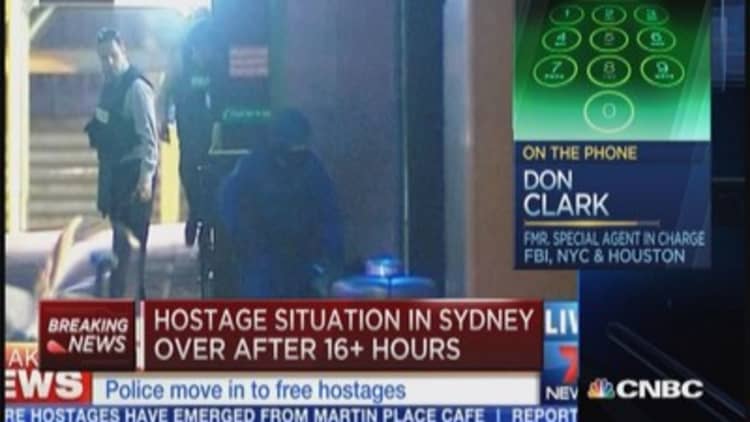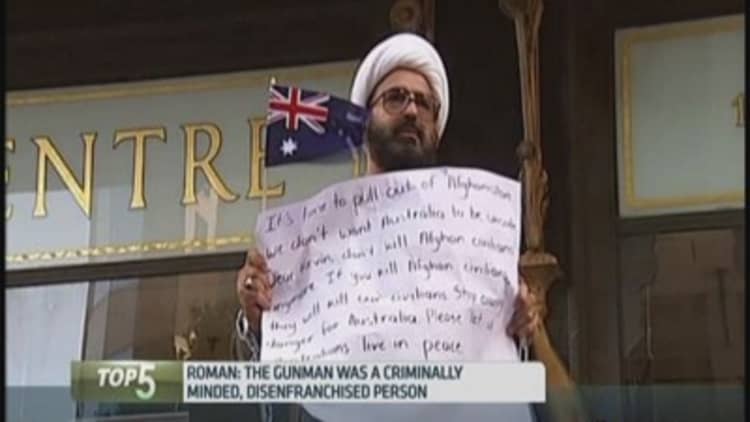Australia is dealing with the aftermath of a 16-hour terror siege that occurred just three months after the country's terrorism alert was raised to its highest level in a decade.
Early on Tuesday morning, gunshots were heard from inside Sydney's Lindt Chocolate Café, where a lone gunman took 17 people hostage on Monday morning at 9:45am local time. Six hostages escaped at the time of gunshots, around 2am, prompting policemen on either side of the building to storm the café.
Armed with guns and stun grenades, police took down the gunman, identified as 50-year old Man Haron Monis, an Iranian refugee. Two hostages were killed during the incident, including the café manager, a 34-year old man. Andrew Scipione, police commissioner for the state of New South Wales, told media that an investigation would be carried out to determine whether the victims were killed by the gunman or if they died in cross-fire.
Read MoreSydney hostage crisis in pictures
Here are a few key questions that arose following the end of Sydney's terror siege.
Who is Monis?
A known figure to Australian police authorities, Monis was a self-proclaimed cleric and spiritual healer who called himself 'Sheikh Haron.' He sought asylum in the country in 1996 and has since been convicted of numerous charges, including over 40 counts of sexual assault and being an accessory to the 2013 murder of his ex-wife. Monis was on bail at the time of Monday's crisis.
Monis was first convicted in 2007 for writing offensive letters to the families of dead Australian soldiers, which he said were an attempt to persuade them to oppose Australia's involvement in Afghanistan.
Read MoreLive blog: Aussie PM speaks on Sydney siege
Also known as Mohammad Hassan Manteghi, media reports say he recently converted to Sunni Islam from the Shia tradition, dominant in Iran, and pledged his devotion to the Islamic State (IS).
On Monday, Monis forced hostages to hold a black flag with Arabic writing, initially believed to be the IS flag. However, the Australian Financial Review later confirmed that it was a Shahada flag, which represents the general expression of faith in Islam and is used by various jihadist groups.

Why Australia?
While the country hasn't experienced as many terrorism-related issues as Western peers, experts say the nation is at risk of attacks given its military action in the U.S.-led 'War on Terror.'
"We've seen attacks in Canada, plots in the U.K. and Europe…this is just the beginning for Australia in what could be a number of attacks," former U.K. government counter extremism task force member Haras Rafiq told CNBC.
Read MoreFour gunmen take hostage in Ghent, Belgium
Australia has also seen an alarming rise in nationals leaving the country to join extremist groups. Officials say 70 nationals travelled to the Middle East to join IS and related groups, with another 100 extremist supporters in Australia. These figures were behind Prime Minister Abbott's decision to raise the terror alert level in September.
In September, the nation saw its biggest ever counter terrorism operation following an alleged plot to behead an innocent civilian.
The rise of 'lone wolf terrorism'
Australian authorities say Monis's actions do not directly stem from IS.
"This person [gunman] in particular did not have direct links with IS, however he did have a link to the ideology that allows him to kill other people for political change. This is indicative of what we have coming and is a warning we have been sounding for years," Rafiq said.

Indeed, Monis is emblematic of the new threat of individual terrorist attacks that governments face. Such individuals subscribe to ideas of large-scale extremist groups like IS, but their violent actions are typically conducted alone.
"The Islamic State is appealing not only to their direct followers but through social media, they are reaching out to people on the fringes, like we saw in the recent Ottawa attack. They have opened up a new front, a new wave of volunteers which are much harder to stop in advance," said Peter King, a member of the U.S. House of Representatives.
Read MoreChaos in Canada's Capital
Will there be heightened Islamophobia?
Monday's attack in Sydney re-surfaced the long-standing issue of public perception against Muslims, a hot-button topic following the September 11 bombings in New York.
Australians have taken a united stance against any potential vilification of Muslims following Monday's. On social media, thousands offered to meet Muslims at public transit stations to accompany them on their journey in case they were scared to go out in public wearing religious attire.
Read MoreZurich airport partially closes after threat
The campaign, called 'I'll ride with you,' has gone viral on Facebook and Twitter.

